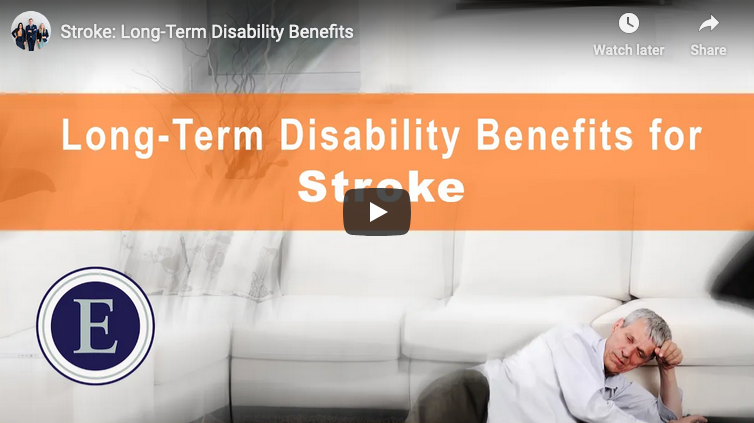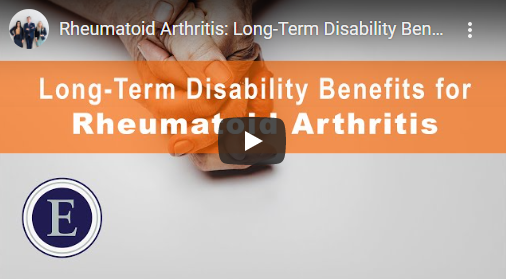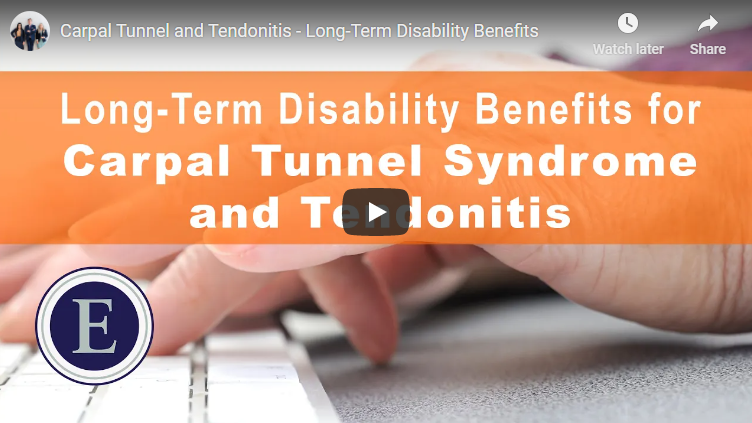Do I Qualify for Long-Term Disability Benefits if I Have Endometriosis?
Can I Get Long-Term Disability Benefits for Endometriosis?
One of the most common questions we get is “Do I qualify for long-term disability benefits if I have Endometriosis?”
Endometriosis is a chronic disorder in which the tissue that normally grows on the inside of the uterus, grows on the outside. Endometriosis causes severe pain that can impact a person’s employment and daily life.
Therefore, Endometriosis can qualify for long-term disability benefits – provided it is not excluded by your insurance policy wording.
LTD Denied? Which Category Do You Fit In?
Category 1: The insurance company denied your initial claim for disability benefits for Endometriosis.
Category 2: The insurance company denied your appeal.
Category 3: The insurance company discontinued or terminated your benefits.
What Can We Do For You?
We’ll work with you and your physician to help challenge the insurance company’s denial or discontinuance of your long-term disability benefits.
Where necessary, we will engage other trusted professionals to support your case including specialists, functional capacity evaluators, and vocational evaluators to help credibly explain why your disability symptoms are preventing you from doing your “own occupation” or “any occupation”.
Our Help Can Make All The Difference. How?
- Over 25 years’ combined experience getting our clients the benefits they deserve.
- Expertise in both disability and employment law (your employment status is directly linked with your disability)
- We offer a free case assessment
- We offer flexible rates, including contingency fees (i.e., only pay if you win)
- Service across all of Ontario


Endometriosis: Overview
Endometriosis is a chronic inflammatory disorder that occurs when tissue forms outside the uterus and can’t exit the body.
It reacts to the hormonal changes the same way endometrial tissue does; it thickens, breaks down, and bleeds during each menstrual period.
But the blood and tissue can’t exit the uterus, so the surrounding tissue becomes inflamed which leads to scar tissue and adhesions.
The cause of endometriosis is unknown, but a working theory suggests retrograde menstruation.
This occurs when blood, which contains endometrial cells, flows back into the fallopian tubes and the pelvic cavity. These cells attach themselves to pelvic walls where they grow and thicken into tissue.
Other medical explanations include:
- Transformation of peritoneal cells
- Embryonic cell transformation
- Surgical scar implantation
- Endometrial cell transport
- Immune system disorder[1]
Though there is no cure, medications can reduce symptoms in some patients. Endometriosis is often mistaken for other painful conditions, such as:
- irritable bowel syndrome(IBS)
- pelvic inflammatory disease (PID)
- sciatica
- urinary tract infection (UTI)
- polycystic ovary syndrome
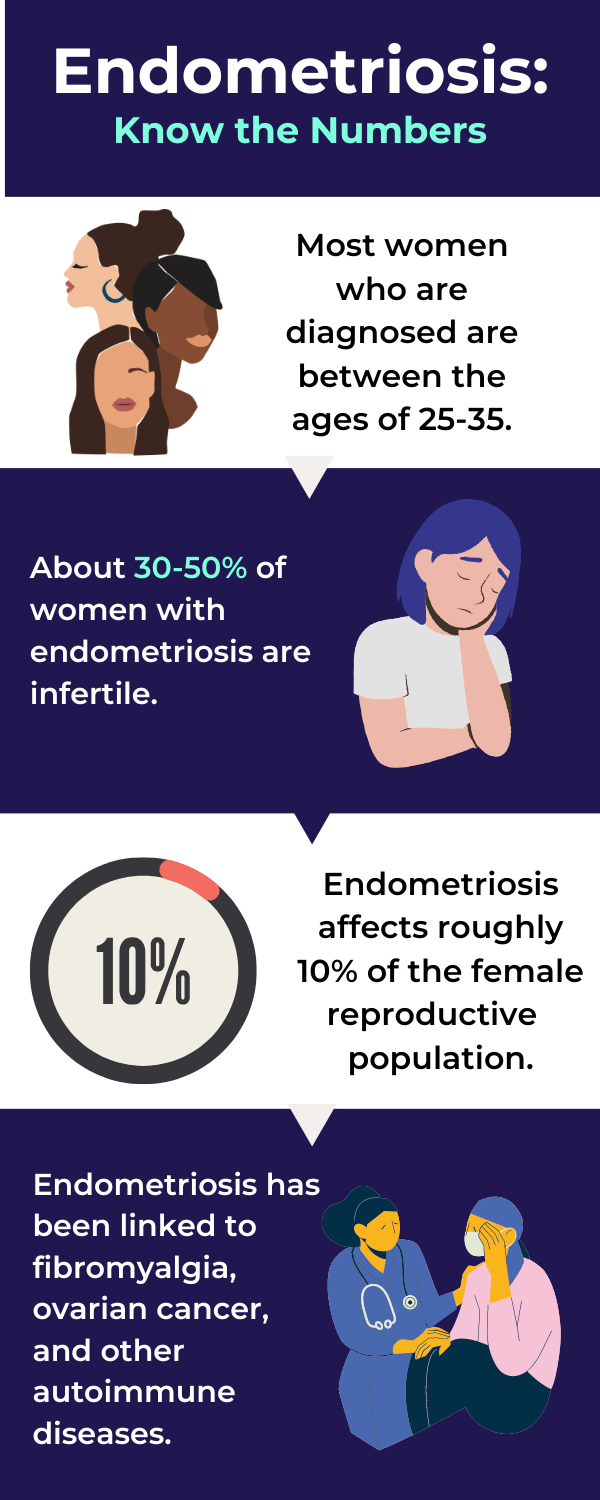
Most Common Symptoms of Endometriosis
Endometriosis is mainly associated with:
Painful periods: Cramps and pelvic pains are severe, and may begin or extend several days before or after your period. Back and abdominal pains are common as well.
Heavy bleeding: Bleeding is irregular and heavy, often occurring between menstrual
Infertility: Endometriosis can cause fertility issues and treatments are often necessary. This is when many diagnoses are made.
Other symptoms can include:
- Pain with intercourse
- Painful bowel movements or urination
- Fatigue
- Diarrhea
- Constipation
- Bloating
- Nausea
Important: Hormonal changes and self-blame can cause people with Endometriosis to become depressed or anxious.
Criteria for a Diagnosis of Endometriosis
There is no single test to confirm if you have Endometriosis.
Doctors will start by asking you to describe your symptoms, including where or when they occur.
Then, your doctor will perform a series of physical exams (pelvic exam, ultrasound, MRI) to identify the tissue growing outside the uterus.
Laparoscopy
This procedure allows surgeons to look inside the abdomen. Under anesthesia, a small incision is made near the navel and a viewing instrument, a laparoscope, looks for irregular tissue growing outside the uterus, as well as cysts caused by endometriosis.
Treatment for Endometriosis
There is no cure for Endometriosis, however symptoms can be treated with both medication-based and hormone therapy-based treatments.
Medication
Over the counter pain relievers (e.g. anti inflammatory drugs, ibuprofen, aleve) are recommended by doctors to ease menstrual pains.
Hormone therapy
Hormonal changes throughout the menstrual cycle cause endometrial tissues to thicken, break down, and bleed. By taking hormone medication, the growth of tissues outside the uterus may slow down and there may be a reduction in menstrual pains. This is not a long-term treatment but it may be effective in improving your quality of life. The following therapies available include:
- Hormonal contraceptives (e.g. birth control, patches, vaginal rings)
- Gonadotropin-releasing hormone (Gn-RH) agonists and antagonists
- Progestin therapy
- Aromatase inhibitors[3]
Surgery
A laparoscopic surgery is performed by making a small incision near the navel and using instruments to identify irregular tissue growth outside the uterus. Another incision is made so that those tissues can carefully be removed. After the surgery, a doctor may recommend hormone treatments to reduce symptoms.
Hysterectomy
Removing the ovaries and uterus was once considered an effective treatment for endometriosis, but hysterectomies result in early menopause and can have a significant impact on your health. Talk to your doctor before making medical decisions.

Parkinson’s Disease & Your Employment
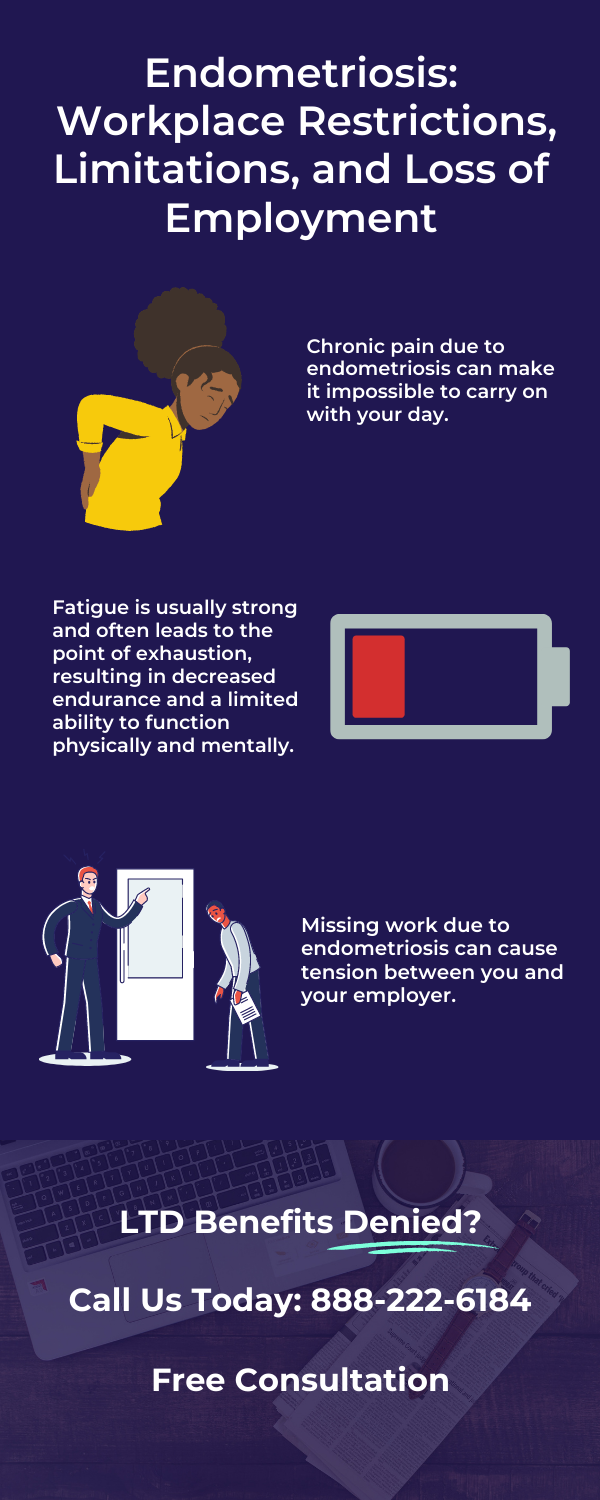
Workplace Restrictions Caused by Endometriosis
When considering your employment and Endometriosis diagnosis, consider how stable your condition is, how safe you are to do your job and what the demands are physically and mentally.
Many individuals suffering from Endometriosis may experience painful periods, heavy bleeding, and fatigue.
Endometriosis and Workplace Discrimination
It is unlawful to discriminate against someone in the area of employment based on their physical disability: Ontario’s Human Rights Code and the Canadian Human Rights Act.
If you are suffering from Endometriosis, you might face discrimination in a variety of ways:
- You experience employment termination because you have Endometriosis.
- You are denied accommodation because of your Endometriosis.
- After returning from a disability leave, your employer places you in a lower, part-time position at a lower rate of pay.
- Someone makes unwelcome remarks or jokes about your disability.
- Someone offends or humiliates you physically or verbally threatens or intimidates you because of your disability.
- Retaliating against you for filing a human rights complaint.
Ertl Lawyers are experts in Employment and Disability Law. If you have been discriminated against, our disability and employment lawyers in Toronto can help, including:
- Having your employer comply with their duty to accommodate you.
- Having your employer stop all forms of discriminatory conduct.
- Representing you in wrongful dismissal in Ontario, constructive dismissal, and human rights matters.
- Ensuring that your employer complies with its statutory obligations, including its obligations under the Employment Standards Act.
- Negotiation severance packages (including continuation of benefits).

Endometriosis & Insurance Companies
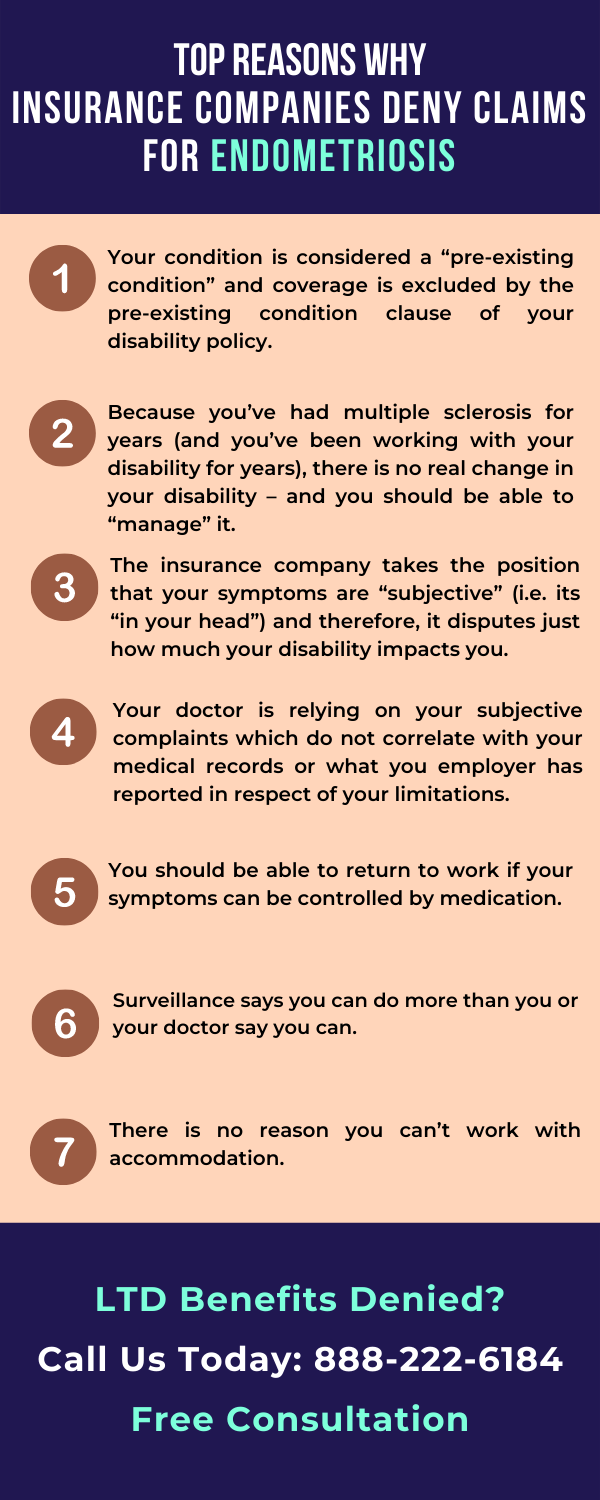
Apply for Long-Term Disability Benefits for Endometriosis?
Review Your Policy Carefully
Your entitlement to disability benefits for Endometriosis depends on the specific wording of your disability policy.
It is important that you understand how the insurance company defines things like “totally disabled,” “occupation,” “mental disorder, “self-reported condition” – and whether any exclusions apply (particularly for pre-existing conditions).
Bottom line: You need to know what your policy says before you apply for benefits.
Gather Medical Evidence
To be entitled to disability benefits for Endometriosis, every insurer requires you to provide medical evidence documenting your diagnosis and that your illness or injury causes restrictions or lack of ability, such that you are prevented from performing the essential duties of your occupation.
It is recommended that you get treated by a medical professional who will diagnose your condition using established criteria.
It is also recommended that you provide to the insurer results of any Functional Capacity Evaluation or cognitive testing that objectively documents your physical and (if applicable) mental limitations.
Gather Evidence of Workplace Limitations
Because your entitlement to long-term disability benefits for Endometriosis depends on the strength of your evidence, you should get a copy of your employee file from work. It may show that your Endometriosis has negatively impacted your work performance. Your work performance may have been affected by your pain, fatigue, cognitive impairment, or other symptoms.
Create a List of the Physical Duties of Your Job
You should get a copy of your job description. Based on that job description, you should write out a detailed list of the physical (and mental) duties associated with your job description – and explain how your Endometriosis limits or prevents you from performing you own occupation.
Follow Your Doctor’s Treatment Plan
Your entitlement to long-term disability benefits also requires you to be receiving regular, ongoing care and treatment for your Endometriosis. In other words, don’t skip appointments, and always follow your doctor’s treatment plans.
Keep a Pain Diary
On your end, it is important to keep a pain diary. A pain diary is a written record that helps you keep track of when you have pain, how bad it is, and whether your treatment is helping.
What Other Benefits Might I Be Entitled to for Endometriosis?
Other than short-term and long-term disability benefits through a group or individual insurance plan, people suffering from Endometriosis might be entitled to one or more of the following benefits:
- Employment Insurance (EI) Sickness Benefits;
- Ontario Disability Support Plan (ODSP);
- Disability Tax Credit (DTC);
- Disability Creditor Insurance (under your mortgage or credit cards);
- Trillium (extended health benefits);
- Canada Pension Plan Disability (CPP-D); and
- Disability Pension (employer).
Organizations / Associations / Colleges
- Endometriosis Foundation of America
- The Endometriosis Network Canada
- World Endometriosis Society
- The Endo Educational Organization of Canada
Disclaimer: The content on this web site is provided for general information purposes only and does not constitute legal, medical, or other professional advice or an opinion of any kind. Users of this web site are advised to seek specific legal advice by contacting members of Ertl Lawyers (or their own legal counsel) regarding any specific legal issues. Ertl Lawyers does not warrant or guarantee the quality, accuracy or completeness of any information on this web site
Sources:
[2] https://www.ccrmivf.com/news-events/endometriosis/
[3] https://www.mayoclinic.org/diseases-conditions/endometriosis/diagnosis-treatment/drc-20354661
Long-Term Disability Benefits Denied?
Ertl Lawyers provides expert representation in long-term disability matters.
The vast majority of disability matters are resolved through negotiation and mediation – and that’s because insurance companies know that we are passionate about our clients’ rights.
How we can help you:
• free disability policy analysis
• free case assessment
• applying for disability benefits
• appealing a denial or termination of your benefits
• disputing a denial through a legal claim
• handling all communications with your employer
• protecting your employment
• prosecuting human rights claims
Fair, Flexible Rates – Including Contingency Fees
(Don’t Pay Unless You Win)
Our Help Can Make All The Difference.
Related Blogs
Heart Disease on the COVID-19 Vaccine Priority List
Heart Disease on the Covid-19 Vaccine Priority List by Linda Noorafkan, Employment and Disability Lawyer COVID-19 isn’t the world’s leading cause of death. It’s heart disease.[1] Heart disease is such a risky condition that, in November 2020, the National Advisory...
COVID-19 Causing Stroke – Even Amongst Youth
COVID-19 Causing Stroke - Even Amongst Youth by Linda Noorafkan - Employment and Disability Lawyer Younger Canadians may think that they’re immune to COVID-19 effects. This is far from the truth. Recently, Riley Behrens, a 23-year-old in Arizona, suffered from a...



